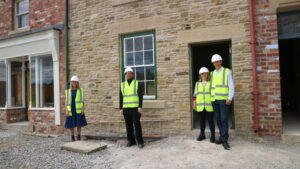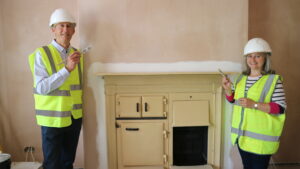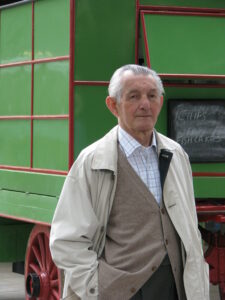Beamish, The Living Museum of the North is offering the unique opportunity for visitors to create pieces of work directly onto the walls of a new Norman Cornish-inspired exhibit.
The exciting Make Your Mark activity, which launches today, will see two people selected to creatively contribute to the walls in No. 2 Front Street on Beamish’s 1950s terrace.
The exhibit is part of our Remaking Beamish project and will tell the story of the Spennymoor Settlement of artists, writers and poets, and will be based on the former home of celebrated artist Norman Cornish.

(l-r) Lisa Kaimenas and Connor Emerson of Beamish Museum with Dorothy and John Cornish, Norman’s son, in front of No. 2 Front Street terrace. The exhibit, inspired by Norman Cornish’s home, is taking shape in Beamish’s 1950s Town.
The Make Your Mark activity is inspired by Norman, who used the freshly-stripped walls of his family home as a giant canvas before they were covered in wallpaper.
Lisa Kaimenas, Remaking Beamish Project Officer – Community Participation, said: “We’re really excited to be launching this activity, which will allow two visitors to create pieces of work directly onto the walls of No. 2 Front Street.
“Sarah, Norman’s wife, told us that Norman could not resist the opportunity to paint the walls of their house before being wallpapered over, we want to do the same in our exhibit. As well as work created by the Cornish family and members of the community, two visitors will personalise the walls with their own creations, this will then be covered over with 1950s-style wallpaper to match Norman’s house on Bishop’s Close Street.
“You can paint, draw, write or colour something that captures your imagination and inspires you. As Norman was told, ‘paint the world you know’!
“This is a really unique and wonderful opportunity for visitors to make their mark on the building and create something that will stay at the museum forever.
“To enter, people just need to send their name, address and age to makeyourmark@beamish.org.uk by 11am on Saturday, 3rd July. Two people will then be picked at random and those lucky winners will personalise the walls of the much-anticipated museum exhibit – good luck!”
No. 2 Front Street is a recreation of 33 Bishop’s Close Street in Spennymoor, County Durham, where Norman lived for most of the 1950s with his wife Sarah and two children Ann and John. The exhibit, which is part of our 1950s Town, is due to open in 2022 and will share the story of the Cornish family.
John was born in 33 Bishop’s Close Street and lived there until he was 11. He said: “My father clearly couldn’t resist the temptation of painting on his living room wall before it was redecorated. Now we are about to recreate that moment in the house at Beamish. Family members are really looking forward to leaving a lasting footprint on the house before it is wallpapered – a unique opportunity for us. We’re delighted to see that the Beamish team will be inviting others to come along and join us in leaving their mark for posterity. Certainly the ‘Make Your Mark’ activity will be really enjoyable and will add character to the home.”

Paint brushes at the ready! John and Dorothy Cornish inside No. 2 Front Street at Beamish. The 1950s exhibit is inspired by the Cornish family home.
John is delighted to see the house based on his family’s former home developing in our 1950s Town. He added: “Seeing our former home at Bishop’s Close Street beginning to take shape was an emotional moment for me. The whole 1950s terrace is really beginning to take shape now and as a family we are delighted that the recreation of our old ‘two up–two down’ colliery house will be part of this new development.
“Not only will the house give visitors an insight into the living conditions experienced by thousands of miners’ families in the 1950s, it will also highlight how my father managed to find a way to develop as an artist in a house that afforded such little space.”
For the Make Your Mark activity, two names will be drawn from a Beamish costume hat on Saturday, 3rd July and will be contacted via email. Those interested need to ensure they can attend the museum on Friday, 16th July to create their piece on the walls of the building at Beamish. The work will be recorded in our photo archive so that it can be viewed by other people.
Lisa said: “We want everyone who contacts us for the Making Your Mark activity to be involved in this unique opportunity, so even if you are not selected to make your mark in No. 2 Front Street, we will contact you to submit a creative piece of work for display in our 1950s Town for all our visitors to see during the opening of Norman’s house and the 1950s terrace.”
For more information about the activity please contact Lisa, email: lisakaimenas@beamish.org.uk.
Norman was born in Spennymoor in 1919. He worked at the nearby Dean and Chapter Colliery in Ferryhill from the age of 14. The renowned painter worked in the pits until 1966 when he left due to a back condition, and became a full-time professional artist.
The Cornish family lived in Bishop’s Close Street until 1967, when they moved to Whitworth Terrace in Spennymoor, where Norman lived for the rest of his life. His paintings captured everyday life in Bishop’s Close Street.
The exhibit at Beamish will share stories of Spennymoor during the decade, including the Spennymoor Settlement, which Norman joined as soon as he was able to on his 15th birthday.
The Spennymoor Settlement was part of a wider national movement and nurtured the talents of artists Norman Cornish, Tom McGuinness, Bob Heslop and Bert Dees, and playwright Sid Chaplin among others.
The Settlement provided free classes and community groups and was an outlet for creativity in an area affected by unemployment and poverty. Norman was advised by warden Bill Farrell to “paint the world you know”, leading Norman to expertly capture the everyday lives of the people of Spennymoor and familiar places.
No. 2 Front Street will have an accessible art space which is inspired by the Spennymoor Settlement. Community groups and learning groups will be able to use this space.
Norman arranged for some of the contents from his house, and from his studio in his later home on Whitworth Terrace, to be donated to the museum. Beamish staff carefully recorded Norman’s house before the contents were moved to the museum. Some of the items from his studio will be on display in the exhibit.

Norman Cornish in front of the Berriman’s chip van that featured in a number of his paintings. Beamish restored the van, which is part of the museum’s collections.
No. 2 Front Street is part of the Remaking Beamish project, which is the biggest development ever seen at Beamish. The £20million project includes a 1950s Town, 1950s Farm, expansion of The 1820s Landscape and transport developments.
The Norman Cornish inspired exhibit will form part of the 1950s terrace, which will also include a hairdresser’s, cafe and fish and chip shop. Visit the recently published Remaking Beamish blog for updates on the project, click here.
Beamish received a Capital Kickstart Fund award of £975,500 from the government’s £1.57billion Culture Recovery Fund for the Remaking Beamish project, which has been delayed as a result of the COVID-19 pandemic.
The Heritage Capital Kickstart Fund is one of the latest grants awarded by The National Lottery Heritage Fund on behalf of the Department for Digital, Culture, Media and Sport, and is specifically aimed at live projects that the coronavirus pandemic has had a negative impact on.
The COVID-19 pandemic continues to have a major effect on the museum and we are extremely grateful for this funding, which has enabled the restart of the Remaking Beamish project and will help us continue to tell the story of everyday life in the North East for generations to come.
Thanks to the money raised by National Lottery players, the project has been awarded a £10.9million grant by The National Lottery Heritage Fund – a major milestone in Beamish’s history and the largest single investment ever seen at the museum.
We are still fundraising for the project match funding, and there is a fundraising plan in place to guide this work.
We have reopened as many of our period exhibits and buildings as possible, and we’re running our 1950s buses, under Step 3 of the government’s COVID- 19 roadmap. We have introduced a range of COVID-19 Secure health and hygiene measures across the museum and have been awarded the “We’re Good To Go” standard. All visitors must book a timeslot entry ticket online in advance, click here.
